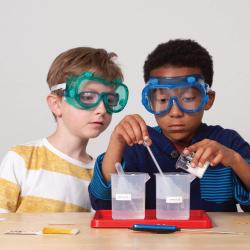Source Institutions
Source Institutions
Add to list Go to activity
Activity link broken? See if it's at the internet archive

"What's in the Water" lets participants use tools to solve the mystery- what chemicals and compounds are in a sample of water? By investigating with a variety of tools and techniques, learners understand how chemistry can help us explore, understand, and solve problems. Activity includes a facilitation guide with potential misconceptions, relevant science infosheets with real-world connections, table sign, and activity training video. All public-facing materials also available in Spanish.
- Under 5 minutes
- 5 to 10 minutes
- Over $20 per group of students
- Ages 6 - adult
- Activity, Experiment/Lab Activity
- English, Spanish
Quick Guide
Materials List (per group of students)
- Citric acid (for sample A preparation)
- Salt (for sample B preparation)
- Warm water (to prepare samples)
- 1/2 teaspoon (to prepare samples)
- 3 250-milliliter beakers (labeled A, B, C)
- 3 1-milliliter pipettes (labeled A, B, C)
- pH paper (2 strips per participant)
- Refractometer
- Digital thermometer
- pH scale graphic
- Pencils
- Tray to hold the samples
- Microfiber cloth (or paper towels)
- Waste container (to dump sample C)
- Marker and labels
Subjects
-
Physical Sciences
-
Heat and Thermodynamics
- Heat and Temperature
-
Chemistry
- Chemical Reactions
- Acids and Bases
- Chemistry of Life
-
Heat and Thermodynamics
Informal Categories
- Nature and Environment
Audience
Learning styles supported:
- Involves hands-on or lab activities
Other
Foreign language versions of this resource:
- Spanish: Activity Guide (Spanish)
- Spanish: Water Test Sheet (Spanish)
- Spanish: Activity Sign (Spanish)
Components that are part of this resource:
- Facilitator Guide
- Activity Sign
- Water Test Sheet
- Activity Guide
- Citric Acid Safety Data Sheet
- Sodium Chloride Safety Data Sheet
- Training Video
Access Rights:
- Free access
By:
Rights:
- Creative Commons: Non-commercial Share Alike (by-nc-sa), Sciencenter, 2018
Funding Source:
- National Science Foundation, DRL 1612482
